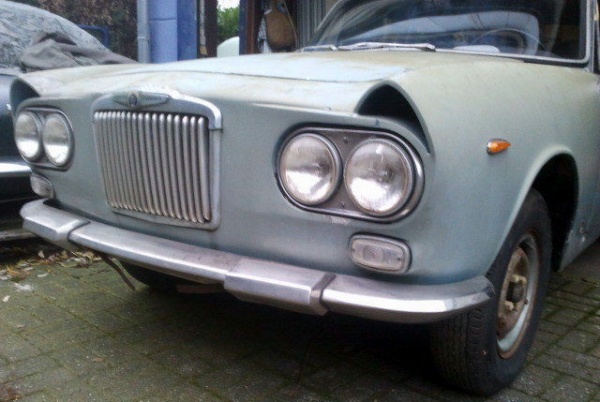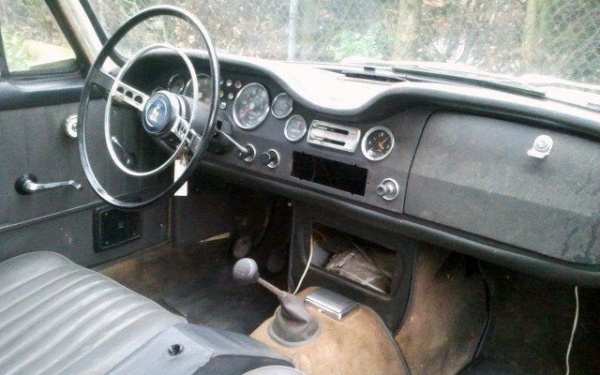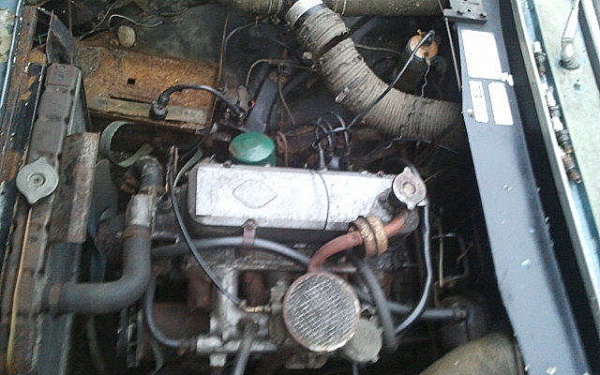
What does this rare Sunbeam Venezia, a Maserati 3500 GT, and an Aston Martin DB4 all have in common? It certainly isn’t a high performance motor or overall straight line performance. The one thing they all share is the construction technique of design house Carrozeria Touring known as Superleggera. This lightweight technique was typically reserved for ultra-high end sports cars, but somehow Sunbeam was able to work out a deal with Touring to build this beautiful little car. There were only about 200 ever built and only a handful are known to exist today. This one has been hiding in a Swiss barn for the past 43 years. It was recently freed from the barn and has now been listed here on eBay out of Germany. Special thanks to Thomas G. for sharing this find with us!

Besides designing and building cars, Touring also performed modifications to individual’s personal cars. Many of their customers brought in their Sunbeam Alpines to be modified and upgraded. Engineer Alec Caine had been charged with all future development of the Alpine and had heard about Touring’s work on the car, so he took an Alpine to Milan and asked the company to work their magic. The result impressed not just Alec, but top brass at Sunbeam’s parent company Rootes. They eventually negotiated a deal to have Touring assemble Alpines and Super Minxes for the Italian market. This new agreement opened the door for the eventual design and production of the Venezia.
 To create the car, Rootes sent Touring a Humber Sceptre chassis with power coming from their 1592cc engine. Touring then built a steel frame, which they then wrapped in aluminum. From there, the well-appointed interior was installed, as was the drivetrain. The first Venezia left the factory in 1963 and was shipped from Milan to Venice for its debut. The car was loaded on a gondola and floated down the city’s canals to Saint Mark’s Square for its reveal. The occasion was overseen by the Mayor of Venice, as well as the British Ambassador. The event was a massive success, even though the car was almost pushed overboard on accident, and made history as being the first car to enter Saint Mark’s Square.
To create the car, Rootes sent Touring a Humber Sceptre chassis with power coming from their 1592cc engine. Touring then built a steel frame, which they then wrapped in aluminum. From there, the well-appointed interior was installed, as was the drivetrain. The first Venezia left the factory in 1963 and was shipped from Milan to Venice for its debut. The car was loaded on a gondola and floated down the city’s canals to Saint Mark’s Square for its reveal. The occasion was overseen by the Mayor of Venice, as well as the British Ambassador. The event was a massive success, even though the car was almost pushed overboard on accident, and made history as being the first car to enter Saint Mark’s Square.

Tour’s Superleggera construction technique produced a very light, yet strong body. There is one major issue with this design though. When aluminum and steel are used together, electrolysis can take place causing serious corrosion. Typically the aluminum goes unaffected, while the steel rusts away. The seller doesn’t state the condition of the floors and doesn’t provide any photos of the underside. Given the long term storage and lack of care, we would go into this project hoping for the best, but assuming the worst. The seller also left out any information on the condition of the motor or transmission. The 1.6 liter straight four is the same engine found in the Sunbeam Rapier and was rated at 88 horsepower. Since the mechanical systems were left untouched, finding parts to get it running should prove relatively painless.

It isn’t every day that a car as rare as this Venezia is pulled from a barn and seeing a find like this gives us hope of one day coming across something this unique ourselves. Tackling this project might prove to be a massive challenge if there is serious corrosion, but if it proves to be fairly rust free it could be a simple and worthwhile project. Sure it’s not a Lamborghini, but this is one Superleggera that most of us could actually afford.


A rare beast it is.
I looks very restorable and the owner seems to have another Alpine sitting next to it..
Offered from Germany in GB (pounds are a $1.50).
That city in Germany is not very big and the name of it is very unusual, and I seem to remember it from other E-bay offers before….(a German flipper ?)
I am waiting for the first mention of those awkward fender scoops….., wait I am the first…
but those actually give that car a unique character…
It’s the same one in the picture.
The front end lets down the design a bit. From the sides it looks like a mildly swoopier Trabant (or other generic 3 box design of the era). It’s interesting, but not for me since it really doesn’t offer a lot of technical advantages over other similarly sized cars with more conventional and easy to care for construction. It’ll probably sell well though as coachbuilt cars of Italian heritage seem to be on the rise due to our newfound love affair with hand made goods in a time of mass machine production.
The Venezia that comes up in the “related finds” feed is the same seller’s other car, which sold last summer for only £2,399. That seems awfully cheap for such a rare and interesting car. It didn’t even look that bad, although from the photos it’s impossible to know what condition the steel substructure was in, beneath the alloy exterior. This car looks marginally better, but again it’s a real crap shoot unless you have a knowledgeable PPI inspection.
The little “ears” on the top of the front fenders were probably a nod to the Rootes styling cues of the period. The Hillman Super Minx has a similar feature, although instead of being open, those pointy bits were occupied by the turn signals:
http://classiccarblog.co.uk/?cat=103
But they do look a little funny today. They make me think of these goofy things:
http://phys.org/news/2011-05-japanese-company-irresistibly-cute-mind-controlled.html
Catwoman’s Catmobile. Yay!
Sad that all that nice aluminum craftsmanship was put onto basically a Rootes Hillman sedan of vintage around 1960-64 or so. One major error in the Barnfind description is that aluminum in contact with steel leads to the steel rotting – this is totally backwards! Having seen lots of aluminum disintegrate in contact with steel on various Citroens (rear alum. suspension cylinders in steel brackets), Pontiacs (alum radiator fins) and learning that Ford’s Escort extruded aluminum Uchannel bumper beams started falling off the car’s steel stroker bumper shocks in the early ’80’s onto Detroit streets from roadsalt corrosion and the electrolytic action of any moisture on that metal combination, I think BF should have their automotive technology comments double-checked by someone who really knows what they’re talking about – aluminum is the sacrificial anode in this metal combo! And having owned two 1960 Hillman Minx convertibles, I can attest to their agricultural design and various other engineering flaws, such as steering shafts known to shear off at the worm/sector box! And terrible accessibility problems on their hydraulic brake & clutch cyls on the firewall. The Sunbeam Alpine did inherit the very strong X-braced chassis, which they needed for convertibles. Even a totally rotted floorpan doesn’t effect the door fit of my ’61 Easidrive convertible, thanks to that massive X brace. As for those air scoops atop the wings, it’s just a repeat of so many funky British styling directors – witness the Mayflower sedan – gotta be one of the most unsightly UK designs of the century – a shrunken Rolls…???
No-one knows everything about everything. One of the great aspects of this site is that people like you can correct any misconceptions or mistakes. There is a deep base of knowledge amongst the readers, so eventually the truth will out. Another great aspect is that Jesse and Josh take on all relevant corrections without offence. This site is more a conversation than it is the axiomatic truth.
As for the Venezia, every time I see one I think of Lee Meriwether as Catwoman in the 1960s Batman movie. I can imagine Barris getting a hold of one of these cars and enhancing it for her use. Mmmmmmm…. Lee Meriwether in a catsuit.
well stated. there is room for everyone on this site. i am having fun and i hope everyone else is too.
Come on admit it. This is a travesty of design. I can see why so few were built.
Looks like the fenders from an earlier model that had single head lights. The “Stuck On” grille
came off a Russian tractor.
No apologies.
This is so typical of Touring designs of the period, especially some Lancia coupes. It’s appealing from the front axle back, but the front end seems to belong to some other car, or maybe a vintage Jeep. The Italian design houses would get orders for a small series and often adapt design features from one of their previous designs, like this Sunbeam and the similar Lancia Touring coupe.
The British magazine ‘Autocar’ used to have cutaway line drawings done to reveal the inner structures of cars they featured, and I remember the DB4’s Superleggera construction looking very impressive. The ‘superlight’ construction was terrific—for a while, until enough metal was lost at the join between the steel supporting tubes and the aluminum body panels so that the panels became detached. Restoring one properly can be very expensive. In the case of a DB4 or a 3500 GT it would likely be worth it given today’s values, but restoring the tubes and panels of this Sunbeam would cost about the same, making it a losing proposition if the body is bad.
The sixties in England was grillework heaven… bordering ghastly design, making a distinctive marque in a small place.
I am a fan of the Rootes Group cars. I really like Rapiers. This does have a very odd look to it in the front….and this left an Italian styling house with that nose?…….
Seems funny the engine has a single carburetor. At least they could have used a setup from the Alpine to help the poor thing down the road.
Many years ago I knew a guy who ran a very small restoration shop and had a DB4. I always admired the car’s beautiful lines, but in the entire time I knew him I never once saw it run. He told me that in addition to attacking the body, electrolysis had also eaten out the bottom end of the engine. I’ve never understood why such otherwise brilliant car makers could have made such a fundamental mistake. The basics of electrolysis have been understood for a long time. Did they not know, or not care?
Touring had a patent on Superleggera (super light) construction, and wanted to make the most of it by providing bodies for high end cars. The method was simple and fast. The designer came up with a body design and workers bent the small diameter tubes to conforn to the body shape and welded them to the chassis and each other. Then lightweight panels were cut and worked into shape either by hammering over a large sand-filled bag or with an English wheel, then attached to the tubes and chassis. Almost everything was done by hand.
This made light, stiff, cheap, great looking bodies. This was Northern Italy not that long after WW2, and there were lots of skilled men who would be glad to get jobs where they could use their skills to make something exciting like sports and GT cars. Some of the best makes of the time used Touring, and they welcomed the business. Italy loved fast, good looking cars, so all this all fit together well.
Whether anyone thought about how the bodies would hold up probably wasn’t as high a priority as running a business and making something fast and beautiful. Did anyone know about galvanic action? Luigi Galvani was an Italian, so probably some people did. But workers were very cheap back then, so if the bodies needed attention it wouldn’t have cost too much to have the work done.
Now, it’s a different story.
I had a Hillman Minx convertible…and a Sunbeam Tiger. Both in their natural and original states were much more appealing than this car.
My Dad had a Hillman Minx, cool little car until my little sister wrapped it around a tree… twice!!!
The Minx was a nice boxy little car with a unique top that would lock in a half-open position. It wasn’t fast but I liked it. And so did girls and in 1963, that was sufficient.(To go fast, I bought a new Mk1A Tiger off the lot a few years later, no test drive necessary, I wanted it in the worst way. Fortunately my wife loved the car also.)
Dolphin, the tutorial on Touring was interesting; thanks for taking the time. The Venezia is still an outstandingly indifferent car.
Are the little scoops over the headlight buckets functional? They look like it could be for cooling purposes since the grill would not allow enough air flow to cool the radiator.
The scoops over the headlights are functional. The rh one supplies air to the heater fan motor, the lh one supplies fresh air to the interior.
The corrosion between the tubes and the aluminum body is not bad at all. The impregnated felt used to separate the two metals works well. How do I know: I am almost done restoring a Venezia. I have seen at least a dozen of them, and the worst corrosion is in the floor panels. And then in the inner rocker panels if the inner fenders have let moisture in, Just as on Alpines and Tigers, All mechanicals are easily obtainable. I drove one this fall for over 500miles, and it is a very comfortable touring car, though could use more power. Competing in its day with V6 Lancia’s and other Italian cars was difficult. Financial and labor troubles at Rootes as well as at Touring did do it in.
Citroen made a mistake when they fastened the vac-formed ABS plastic body panels to the tubular steel support structure on their Mehari mini-jeep in the late ’60’s. The engineers specified aluminum pop rivets thru the plastic into the steel tubes. Guess what disappeared via electrolysis? If the ABS panels didn’t flex fatigue and crack from UV attack – its color was integral, so no paint was on it to protect it from UV embrittlement and discoloration – the rivets disappeared and the panels fell off! My early ’50’s Jowett Jupiters have all-aluminum bodies pressure-formed into female dies using 16 gauge sheet – thickest alum. panels I’m aware of in the industry to date – but are hand-flanged and joined to each other with brass screws and insulated from the chrome-moly tube chassis with either a felt or other nonconductive strip. My first car came off a 30 deg. slope on the bay side of Mill Valley Ca. near Sausalito, and had sat outside for 40 yrs collecting moisture from the Pacific, yet it shows no electrolytic corrosion – just bare aluminum. The sheet steel cowl & firewall lost its bottom 2 inches however. I was amazed at the lack of corrosive damage to the alloy panels. Still don’t know if the metal was some special aircraft grade or whatever more resistant to corrosion or if the mounting technique alone saved it.
As with the Venezia, the Jupiter body design isn’t exactly an XK Jag shape – more like one cranked out when Sir Wm. Lyon was on a bender……